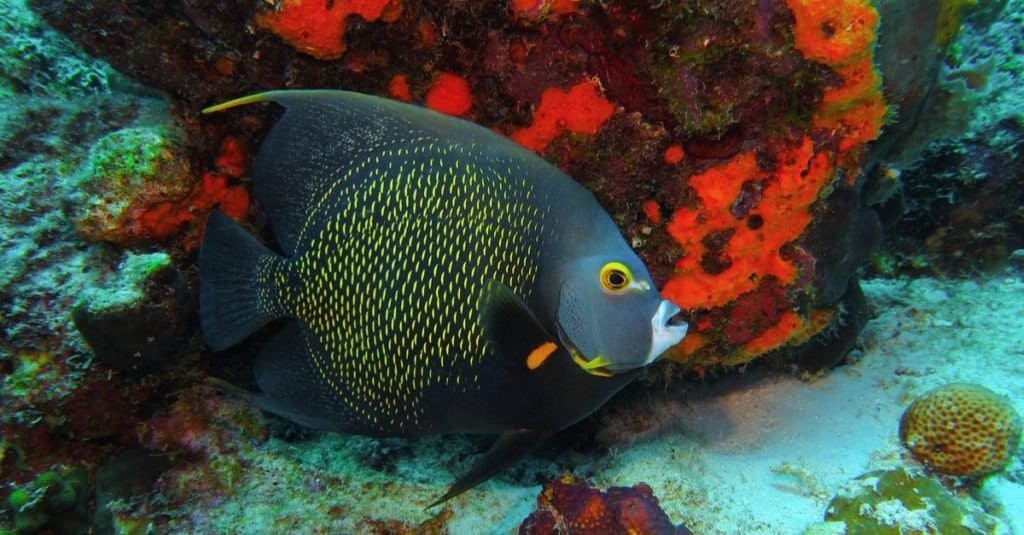Angelfish
.jumbotron {
background-image: url(“https://a-z-animals.com/media/angelfish-4-400×300.jpg”);
}
}
@media only screen and (min-width: 641px) and (max-width: 920px) {
.jumbotron {
background-image: url(“https://a-z-animals.com/media/angelfish-4-470×370.jpg”);
}
}
@media only screen and (min-width: 921px) {
.jumbotron {
background-image: url(“https://a-z-animals.com/media/angelfish-4.jpg”);
}
}
Angelfish
95% of angelfish eat sponges
Angelfish Scientific Classification
Read our Complete Guide to Classification of Animals.
Angelfish Conservation Status
Angelfish Facts
- Main Prey
- Sponges, algae
- Group Behavior
-
- Social
- Fun Fact
- 95% of angelfish eat sponges
- Estimated Population Size
- Unknown
- Biggest Threat
- Water pollution
- Most Distinctive Feature
- Brightly colored scales
- Gestation Period
- 1-3 days
- Optimum pH Level
- 6.5 – 7.2
- Habitat
- Coral reefs
- Predators
- Larger fish, barracudas, sharks
- Diet
- Omnivore
- Favorite Food
- Fish
- Type
- Perciformes
- Common Name
- Angelfish
- Number Of Species
- 90
- Slogan
- There are 70 different species!
This post may contain affiliate links to our partners like Chewy, Amazon, and others. Purchasing through these helps us further the A-Z Animals mission to educate about the world’s species..

Spiders that fly! Fish that walk! And 1000+ more incredible animals. Discover them all for FREE
.photo-gallery {
–margin: 0px auto 0px;
–padding: 0px 0px 0px 0px;
}
.gallery-link {
background-image: url(“https://a-z-animals.com/media/angelfish-4-1024×535.jpg”);
background-repeat: no-repeat;
background-size: cover;
background-position: center;
height: 500px;
justify-content: center;
text-align: center;
align-items: center;
display: flex;
border: 2px solid #000;
}
.gallery-link img {
height: 50%;
}
@media only screen and (max-width: 768px) {
.gallery-link {
height: 300px !important;
}
}
View all of the Angelfish images!
Angelfish are known for their brightly colored scales.
There are 90 species of marine angelfish. These omnivorous fish live in the Indian, Atlantic, and the western Pacific Ocean. They swim in and out of coral reefs in shallow areas of water.
3 Incredible Angelfish Facts!
- Changing Colors: One of the most interesting facts about these fish is it changes colors as it gets older. For instance, a young angelfish’s black stripes may fade into yellow ones as it ages. Health, nutrition, and breeding activities can also bring on changes in color.
- Female Changes to Male: Angelfish are known as protogynous hermaphrodites. This means a female change into a male at a certain point in her life.
- A Pancake Shape: The body of an angelfish is flat and thin like a pancake. This allows them to slip through the crevices and narrow holes in a coral reef. They can escape a predator this way or access algae or other plant life for nourishment.
Angelfish Classification and Scientific Name
The scientific name of a marine angelfish is Pomacanthidae. The word Pomacanthidae is Greek meaning ‘cover thorn.’ This refers to the spiny growth that all angelfish have on their bodies. The spiny growth may be on its head or near its tailfin.
It belongs to the Pomacanthidae family and the class Actinopterygii.
Some of the species include:
- Emperor angelfish
- Queen angelfish
- French angelfish
- Blue angelfish
There are 90 species of these fish. Their family is divided into 7 genera.
Angelfish Species
Many angelfish live near coral reefs. Lots of these coral reefs are located in the Caribbean Sea. Look at some of these fish that live near coral reefs in the Caribbean.
- Emporer angelfish: This fish is one of the bigger species at 15.75 inches long. Adults are easy to recognize due to their vibrant blue and yellow stripes. It eats sponges and algae from on and around coral reefs.
- Queen angelfish: This fish, sometimes called the Blue Queen, is another large species measuring 18 inches in length. They can be blue or blue and yellow in color. Sponges are the main diet of this fish. It eats jellyfish as well.
- French angelfish: A French angelfish is black with distinctive rings of yellow around its eyes. It lives on coral reefs in the eastern region of the Caribbean. As with most species, sponges are the main diet of this fish.
Angelfish Appearance
These fish can be red, blue, green, black, or yellow, or a combination of these colors. Some marine angelfish have scales with swirling colorful patterns, others have stripes while others are mostly solid in color. They have a thin, flat body with curved dorsal and anal fins. They have feathery pectoral fins along with dark eyes and a small mouth. All angelfish have a thorn or a spiny growth, somewhere on their body. In fact, their scientific name Pomacanthidae is Greek for cover thorn.
Most angelfish are 8 to 12 inches long and weigh up to 2 pounds. Of course, there are some species that are smaller or larger. For instance, koi angelfish grow to be just 6 inches long. The largest species is the gray angelfish. This fish measures 24 inches in length and can weigh up to 4 pounds!
The thin, flat body of the fish allows it to slip into hard-to-reach places which can help it to escape some of its predators. Plus, most of these fish feature brilliant colors so you would think they would be easy for predators to spot. However, they’re able to blend in with the brightly colored rocks, algae, and other features in their coral reef habitat.

blue-sea.cz/Shutterstock.com
Angelfish Distribution, Population and Habitat
These fish are found in the Indian, Atlantic, and western Pacific Oceans. They live in a warm, saltwater habitat and don’t migrate. You can find them in shallow water near coral reefs in the Caribbean. The Belize Barrier Reef, Great Barrier Reef, and the New Caledonian Barrier Reef are a few of the places where these fish live. They aren’t known to dive deeper than 160 feet.
The exact population of these fish is unknown. However, most species have a conservation status of Least Concern with a stable population. The Emporer, the Yellow, the French and Blueface angelfish are a few species with that designation.
The Bluespotted angelfish is one exception with a conservation status of Data Deficient. Habitat destruction is the reason for the low population of this fish.
Angelfish Predators and Prey
These fish are omnivores. Sponges are their main diet. They also eat algae and small pieces of shrimp. Some larger species such as the Queen angelfish eat bigger types of prey like jellyfish. These fish hunt during the day time and hide in the coral reef at night where it’s safe.
What eats angelfish?
Some of their predators include larger fish, sharks, and barracudas. These are all animals that share a habitat with these fish.
What do angelfish eat?
Angelfish fish eats sponges, pieces of shrimp, and algae. The larger species of this fish are able to eat bigger sorts of prey.
The conservation status of most species is Least Concern with a stable population.
Angelfish Reproduction and Lifespan
These fish spawn in the winter season. They are polygynous (have multiple partners). The male flaps its pectoral fins to attract females. A male usually has a group of 4 females, also called a harem, to mate with. One of the most amazing facts about an angelfish is if a male leaves a harem of females, one of the females changes into a male and takes his role.
After mating, a female lays at least 500 eggs. Some species lay more. The Queen angelfish can release 75,000 eggs! The eggs float in the water for 1 to 3 days until they hatch into larvae. Larvae survive on algae and plankton as they grow into adult fish.
Though the larvae are clear, they are vulnerable to being eaten by small or large fish passing by. This is why angelfish have such a large number of eggs. So, at least some are likely to survive into adulthood. The mother and father are not involved with their young once they are released as eggs.
Sexual maturity is reached between 6 and 12 months of age. The lifespan of an angelfish is up to 15 years.
Angelfish in Fishing and Cooking
These fish are not a major target of commercial fishermen. However, they are sometimes caught and sold to pet stores and breeders. Some fish hobbyists like to put them in their tropical aquariums at home. They are colorful additions to aquariums in businesses, too.
These fish are not a popular item for people to eat, but some people consume them. They are known to carry parasites and bacteria that could be harmful to someone who eats one.
View all 127 animals that start with A
Angelfish FAQs (Frequently Asked Questions)
Where are angelfish found?
Angelfish are found in the Indian, Atlantic, and western Pacific Oceans. They live in warm, saltwater habitats usually near coral reefs.
What eats angelfish?
The predators of angelfish include larger fish, sharks, and barracudas.
What do angelfish eat in the wild?
One of the main facts to remember about these fish is they are omnivores. They eat mostly sponges. Algae, shrimp pieces, and plankton are other items in their diet.
How long do angelfish live?
These fish have a lifespan that can go up to 15 years.
Are angelfish aggressive?
Yes and no. Angelfish can be very aggressive with other angelfish in an aquarium especially if it’s not a large enough habitat. For instance, putting a koi angelfish in an aquarium with another koi angelfish could result in fighting. It’s best to research which types of fish it can be paired with, in a safe way.
Plus, though they travel through the ocean in small groups, angelfish fight and challenge one another over territory.
As a note, many larger species of angelfish have been known to swim around divers and follow them out of curiosity.
What Kingdom do Angelfish belong to?
Angelfish belong to the Kingdom Animalia.
What phylum do Angelfish belong to?
Angelfish belong to phylum Chordata.
What class do Angelfish belong to?
Angelfish belong to the class Actinopterygii.
What family do Angelfish belong to?
Angelfish belong to the family Pomacanthidae.
What order to Angelfish belong to?
Angelfish belong to order Perciformes.
What type of covering do Angelfish have?
Angelfish are covered in Scales.
What are some predators of Angelfish?
Predators of Angelfish include larger fish, barracudas, and sharks.
What is the main prey for Angelfish?
Angelfish prey on sponges and algae.
What is an interesting fact about Angelfish?
There are 70 different species of Angelfish!
What is a distinguishing feature of the Angelfish?
Angelfish have brightly colored scales.
How many species of Angelfish are there?
There are 90 species of Angelfish.
What is the biggest threat to the Angelfish?
The biggest threat to Angelfish is water pollution.
What is the optimal pH for an Angelfish?
The optimal pH for an Angelfish is between 6.5 and 7.2.
How many Angelfish are left in the world?
The population size of Angelfish is unknown.
How do Angelfish have babies?
Angelfish lay eggs.
How to say Angelfish in …
Kaiserfische
Marine angelfish group
Pomacanthidae
Keisarikalat
Pomacanthidae
Pomacanthidae
Injel
Pomacanthidae
キンチャクダイ科
Engel- of keizersvissen
Keiserfisker
Pomakantowate
Pomacanthidae
Kejsarfiskar
蓋刺魚科
Sources
- Wikipedia, Available here: https://en.wikipedia.org/wiki/Pomacanthidae
- Animal Diversity Web, Available here: https://animaldiversity.org/accounts/Holacanthus_ciliaris/
- Lamar University, Available here: https://www.lamar.edu/arts-sciences/biology/marine-critters/marine-critters-2/french-angelfish.html
















